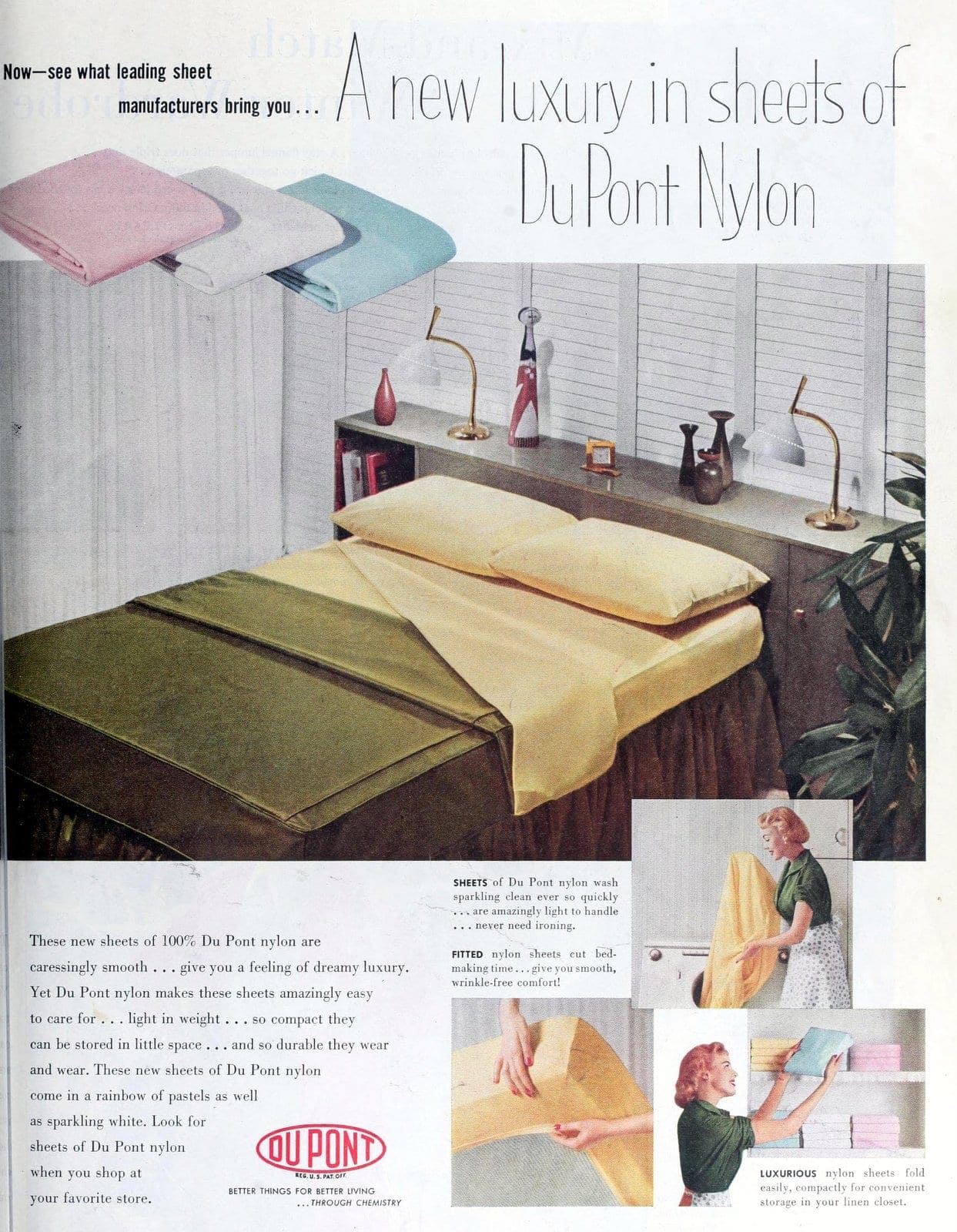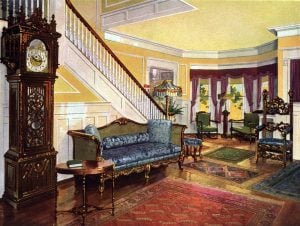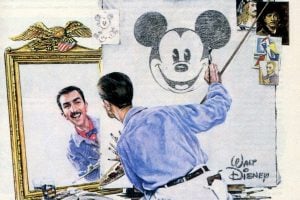The history of fitted sheets: A revolution in bed-making
As members of the Boomer and Silent Gen will attest, before that time, folks just used flat sheets, and folded them neatly around the corners of the bed (called “hospital corners “or “square corners”) and hoped they didn’t slip off in the night.
Marketing efforts of this innovation touted the time-saving benefits of fitted sheets…
After a careful study of the time-saving factor, it has been estimated that the use of fitted sheets frees one eight-hour day of work, per year, per bed. As the American family averages 3.4 beds per household, this adds up to nearly 30 work hours saved per year.
… but failed to include in their calculations how much time was lost in folding the darn things. They did, however, offer a step-by-step illustrated how-to, which we’ve helpfully included below, since, you know, we figure there’s a 95% chance that if you’re reading this, you are also looking for guidance in mastering this elusive skill.
If you want a modern-day guide with photographs, be sure to check out How do you fold fitted sheets? (Yes, it actually CAN be done) on our partner site, Lilyvolt.
How to care for the popular new fitted sheets (1954)
From the Lansing State Journal (Lansing, Michigan) January 21, 1954
To buy or not to buy fitted sheets? That’s the question facing half the homemakers in America today. With white sales dominating the January scene, now is the time to discuss the pros and cons of this newest major innovation in household linens.
Whether it is initial bedmaking, or in the subsequent days of remaking, fitted sheets eliminate much of the trudging back and forth, side to side, head to foot routine.
They eliminate, too, the tugging, folding and meticulous squaring of the sheet to effect hospital corners. The problem of remaking the corners pulled out by a restless sleeper is eliminated also, according to the Bureau of Industrial Services.

Actually, fitted sheets are past the experimental stage. They have been on the market for five years, and a recent survey shows that 85 out of every 100 women know about them.
Forty-five percent of these 85 have tried them, and nearly all of them have bought more or indicated they plan to buy more of these new sheets.
Did you know that the first fitted sheets were crib sheets? They were introduced on the Pacific coast in the early 1940s by a children’s wear manufacturer. (See more on that topic in our article, Vintage baby gear from the 1950s: Playpens, strollers & more.)

Fit all mattresses
Today, most manufacturers make and sell fitted sheets in sizes for single, double, twin, and three-quarter beds.
The specially shaped corners are adaptable to all mattresses, whether they are the innerspring type or thinner ones of yesterday. There are special fitted sheets in white only for use on foam rubber mattresses, too.
DON’T MISS: Did married couples really sleep in separate beds back in the ’50s?

The three main points in favor of fitted sheets are that (1) they save time and labor for the housewife; (2) they increase the comfort of the sleeper; (3) they make a smoother, neater, more efficient bed.
After a careful study of the time-saving factor, it has been estimated that the use of fitted sheets frees one eight-hour day of work, per year, per bed.
As the American family averages 3.4 beds per household, this adds up to nearly 30 work hours saved per year.

Fitted sheets make it easier for the children to make their own beds each morning. This is a real lift for the busy homemaker and good training for the youngster.
For women who “wash their own” at home or at the community laundry, very real labor savings can be affected by the elimination of ironing.
Even the most meticulous housekeepers are pleased to see how the laundry-wrinkled sheets stretch out to a crisp, smooth appearance on the bed.
MORE: See the old-fashioned clock radios that used to be on almost every bedside table
Increased comfort from fitted sheets
These sheets with mitered corners that fit snugly over the mattress are wonderfully comfortable to sleep on. They conform to the mattress and give it a firmer feeling.
There is no wrinkling or bunching, so the sleeper feels like he or she always has a freshly-changed bed. This wrinkle-free quality produces sounder, more relaxed sleep This, in turn, makes for better health.

The price factor
There is little if any price differential in the initial cost of fitted sheets versus regular sheets. Further, most commercial laundries do not charge more for one type than the other.
However, because there are fewer square feet of fabric in fitted sheets, there is less poundage, and hence a saving when laundry is sent out “by the pound.”

Fitted sheets are hard to fold and iron neatly. If you don’t have the know-how, the corner pockets crease and bulge, and the sheets are awkward to handle. The result is a scraggly sheet stack in the linen closet.
This was a real problem in earlier years, but today, linen departments of retail stores all over the country have folders illustrating six progressive steps for quickly and efficiently folding fitted sheets into neat smooth rectangles. Some manufacturers include the directions in the packaging.
Fitted sheets provide no rotations. An early study showed that 50 percent of the housewives rotate their sheets. In other words, they put the bottom sheet in the laundry each week, move the top sheet to replace the bottom sheet, and add a clean top sheet. By so doing, each sheet remains on the bed twice a week.

Several alternatives
With fitted sheets several alternatives are possible. Since they remain fresher, they may be used for a two-week period and both sheets unchanged, or the top sheet may be used for two weeks and the bottom one changed each week.
Instead, two top sheets, mitered only on one end, may be used, and the second week, the top sheet may be placed on the bottom with the mitered end at the top of the bed.
MORE: Vintage ’50s master bedroom decor: See 50+ examples of retro home style

No homemaker can, of course, discard her present supply sheets. However, the oldsters in the sheet pile do get retired, and today’s homemakers are replacing them with fitted sheets, continuing to use their old stock as top sheets.
Records show that most women today buy two fitted sheets as a trial purchase, and within six months order two or four more.
The biggest users of fitted sheets today are among the 25- to 35-year-old group of homemakers. Records show that today one out of every five sheets sold is a fitted sheet.

1950s instructions on how to fold fitted sheets (1954)
By Lansing State Journal (Lansing, Michigan) January 21, 1954
1. Fold the sheet lengthwise once by bringing the two selvage edges together. allowing corners at both ends to hang loose. (Pockets should be right-side-out )
2. Place sheet on ironing board with selvage edges towards you. With the left hand, pick up the extreme left end of the sheet, and with your right hand, push the top pocket down into the bottom pocket. Bring the extreme left end of the sheet over towards selvage edges as indicated.
3. The left end of the sheet now looks like this. To accomplish a similar fold at the other end of the sheet, push the top pocket into the bottom pocket, fold, and smooth out as you did on the left end.
4. Sheet now looks like this. (If you wish to iron your fitted sheets, press all flat surfaces.)
5. Fold sheet in half by bringing center fold over to selvage edges, as shown in the illustration.
6. Fold both ends to the middle and fold in half again, as many times as you wish. If you’re been careful to buy your fitted sheets labeled “Sanforized”, they will always fold to the same exact dimensions.
ALSO SEE: How do you fold fitted sheets? (Yes, it actually CAN be done)

Vintage fitted sheets of the 1960s
By the 60s, fitted sheets were so commonplace, women apparently had time to lounge around the bedroom, admiring their bedding.

AND BEYOND! Retro 1970s sheet sets with bright & bold colors and bonus flower power



















